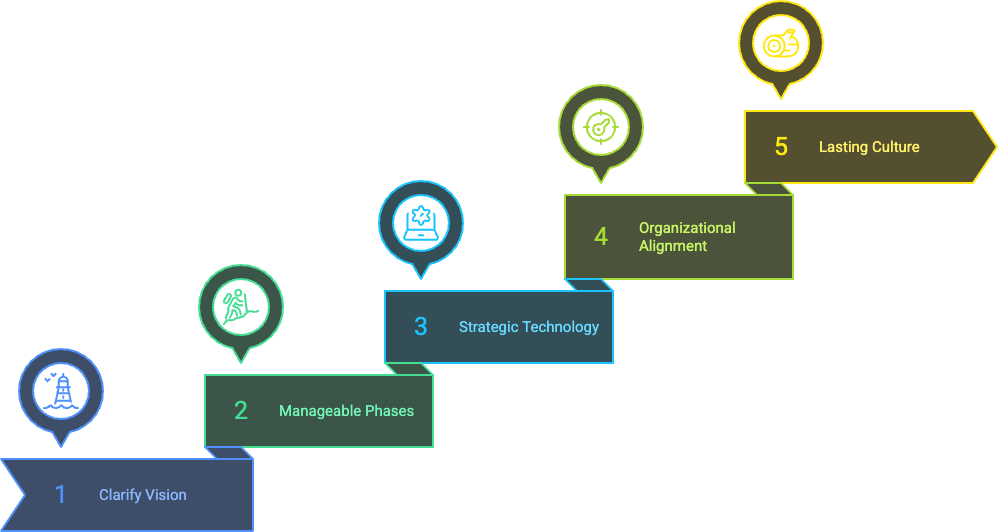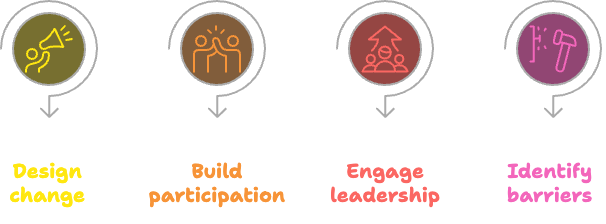Table of Contents
- 1. Why Is Corporate Transformation a Critical Process?
- 2. Why Do Transformation Projects Fail?
- 3. Why Is Consulting Necessary in This Process?
- 4. Lack of a Clearly Defined Vision
- 5. Organizational Resistance and Lack of Participation
- 6. Overemphasis on Technology
- 7. Communication Gaps
- 8. Unrealistic Outcome Expectations
- 9. How Does Consulting Resolve These Issues?
- 10. Why Should a Strategic Roadmap Be Defined?
- 11. How Is Organizational Alignment Achieved?
- 12. Why Are Measurement and Monitoring Mechanisms Necessary?
- 13. How Can a Transformation Culture Become Permanent?
- 14. What Are the Long Term Effects?
1. Why Is Corporate Transformation a Critical Process?
Corporate transformation is a strategic journey that requires a company to redefine its ways of working, internal processes, and organizational culture. In an era where change is this rapid, it is increasingly difficult to maintain a competitive edge with existing structures.
Therefore, transformation is not a choice but a necessity. Digitalization, artificial intelligence, automation systems, data driven decision making, and agile business models are reshaping the fundamental building blocks of companies.
A successful transformation is not limited to technology investments. It also means updating the company culture, reshaping management processes, and enabling employees to adapt to a new vision. For this reason, the transformation process must be managed with a holistic strategy that covers all layers of the organization.
2. Why Do Transformation Projects Fail?
A large share of corporate transformation projects fail to reach the intended outcome. Research clearly shows that a significant portion of such initiatives do not succeed.
The main reasons include inadequate planning, lack of a clear vision, overemphasis on technology, organizational resistance, and weak communication.
Many companies view transformation merely as an IT investment. Yet transformation requires far more than technology. When this perspective is incomplete, even well intentioned efforts cannot create real organizational change.
Another reason for failure is the insufficient consideration of the human factor. When employees are not involved or the rationale for change is not clearly explained, projects encounter internal resistance. Consequently, even well designed plans become ineffective in practice.
3. Why Is Consulting Necessary in This Process?
Corporate transformation is not only the deployment of new technologies but also the coordinated management of people, processes, and culture. For this reason, it often cannot be managed optimally using only internal resources.
Professional consulting steps in here to make the transformation more strategic, structured, and measurable. Consultants address not only technical infrastructure but also critical elements such as organizational structure, leadership approach, employee experience, communication planning, and measurement mechanisms.
With consulting support, companies:
• Clarify their vision,
• Break the journey into manageable phases,
• Position technology as a strategic tool,
• Strengthen organizational alignment,
• Turn transformation into a lasting culture.

4. Lack of a Clearly Defined Vision
One of the most common causes of failure in corporate transformation projects is a lack of vision. Many companies begin with a general intention to improve without setting clear goals. If the vision is unclear, the direction of strategic actions becomes uncertain.
An undefined vision prevents both internal teams and project leaders from moving in the same direction. This leads to lost time, misused resources, and declining motivation.
Consulting ensures that the vision is defined at the outset. The company’s strategic goals are set, the importance of these goals is articulated, and a shared understanding is created among all stakeholders. Thus, the transformation moves from a series of ad hoc initiatives to a focused pursuit of clear objectives.
5. Organizational Resistance and Lack of Participation
The human dimension is one of the most critical factors in corporate transformation. No technology investment or process redesign can succeed if it is not aligned with the organization’s internal dynamics.
Especially in periods of uncertainty, employees naturally resist change. This resistance may be overt or show up as passive resistance. It slows projects, weakens communication channels, and hampers adoption.
Consulting addresses this by focusing on understanding employee concerns, involving them in the process, and building a participatory transformation culture. With clear messages, open channels, and inclusive practices, organizational resistance is reduced. Transformation stops being “a project” and becomes the organization’s shared goal.
6. Overemphasis on Technology
Many organizations equate transformation with technology spending. New software, automation, and AI solutions are important parts of the journey, but technology alone never produces transformation.
If people and processes are overlooked and only technology is funded, results often fall short. This approach puts a cosmetic layer over structural problems rather than solving them.
Consulting reframes technology as a strategic means, not an end. Investments are positioned to serve company goals. A framework aligned with processes, organizational structure, and cultural change is established. As a result, returns on investment improve and genuine corporate transformation is achieved.
7. Communication Gaps
For transformation projects to succeed, communication must be the load bearing pillar of the process. Yet many companies neglect this critical element.
Poor communication increases uncertainty, spreads rumors, lowers motivation, and strengthens resistance. If employees do not understand why change is happening or how it affects them, they will not own the process.
An effective communication strategy means not only informing but also enabling participation, building trust, and sharing the vision. Consulting clarifies who says what, to whom, when, and through which channels, thereby strengthening the communication backbone. Transformation then becomes a process understood and owned across the organization.
8. Unrealistic Outcome Expectations
One of the most common mistakes in transformation projects is mismanaging expectations. Many companies expect dramatic impact in the short term, which creates pressure on teams and undermines sound strategic planning.
In reality, corporate transformation is not a sprint but a long distance run. Technical adaptation, cultural change, and process stabilization take time. Moreover, impact emerges step by step through a sound plan, not in the first weeks alone.
Consulting helps define realistic milestones, measurable targets, and concrete timelines. When expectations are managed well, teams adopt the process more easily and an aligned rhythm forms among investors, top management, and employees.
9. How Does Consulting Resolve These Issues?
Professional consulting offers a structured solution to all these issues. Transformation ceases to be an IT centered exercise and becomes a strategic, cultural, and operational journey.
Consultants begin by analyzing the company’s goals and current state. Based on this, they define a clear vision and build a roadmap aligned with the organization. Technology is positioned as a leverrather than the goal. Employee participation is increased, communication is strengthened, and measurement mechanisms are established.
Most importantly, the process does not rest solely on internal teams. An independent, professional third eye manages the journey with a neutral and strategic perspective. This enables early detection of issues and keeps the program on track with effective remedies.
10. Why Should a Strategic Roadmap Be Defined?
A clear strategic roadmap is essential for a successful transformation. It acts as the compass that sets direction. Without clear goals, efforts scatter and the process becomes unmanageable.
A roadmap is not just a document created at the start. It is a living guide that informs decision making, ensures efficient resource allocation, and strengthens cross team coordination throughout the journey.
Consulting ensures the roadmap is built correctly. Goals are made concrete, milestones are clarified, responsibilities are assigned, and the timeline is structured. The result is a process that is both controllable and measurable, one of the most commonly missing elements in transformation programs.
11. How Is Organizational Alignment Achieved?
A lasting transformation requires the entire organization to align with the journey. Not only senior leadership but all employees must understand and own the vision; otherwise it remains a “management decision” and does not deepen.
Alignment comes from active participation, a clear narrative for change, concern management, and sustained motivation. This does not happen on its own. Consulting provides a systematic approach to secure alignment.
Consultants:
• Design change communications,
• Build participation mechanisms,
• Engage leadership teams,
• Identify cultural barriers and craft solutions.

12. Why Are Measurement and Monitoring Mechanisms Necessary?
Unmeasured transformation cannot be managed. For success, you need not only a planned start but also effective monitoring and evaluation mechanisms. Without them, the company cannot know whether it is progressing, what the return on investments is, or how much the cultural shift is being adopted.
Consulting creates program specific KPIs, success indicators, and feedback loops. These metrics are more than reporting tools; they guide strategic decisions, surface risks early, and serve as levers that increase strategic agility.
With the right measurement structure, companies:
• Optimize resource use,
• Detect delays early,
• Track success with data,
• Align operational execution with strategic goals.
This makes the journey predictable and manageable.
13. How Can a Transformation Culture Become Permanent?
True transformation is measured not when the project ends but when the transformation culture is embedded in the organization’s DNA. In many companies, momentum fades once project teams disband or consulting ends, limiting long term value creation.
To build a lasting culture, the organization must evolve into a learning structure. This means changing how people think, not just how processes run. Employees should adopt new technologies, internalize new processes, and see change as natural.
Consulting focuses on building the structures that make cultural change endure. Leadership programs, continuous learning mechanisms, internal communication strategies, and agile ways of working are the building blocks. Transformation then stops being a project and becomes the company’s natural way of operating.
14. What Are the Long Term Effects?
When designed correctly and supported by professional consulting, corporate transformation generates long term strategic outcomes that shape the company’s future.
- Competitive advantage strengthens. The adoption of new technologies and agile processes enables faster market adaptation.
- Operational efficiency rises, costs decrease, and resource use becomes more optimized.
- Employee engagement and talent attraction improve, because a transformation culture makes the company a more innovative and attractive employer.
- Customer experience is reinvented.
Organizations that respond faster, make data driven decisions, and continuously improve their processes deliver more value to customers, strengthening the brand’s long term position.
All these effects show clearly that when planned properly and supported by consulting, transformation is not a cost center but a high return investment.




